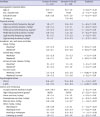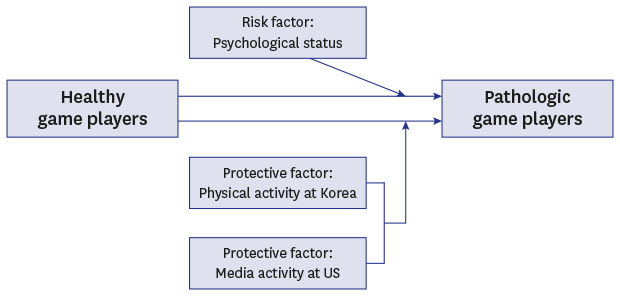1. Lam LT, Peng ZW, Mai JC, Jing J. Factors associated with internet addiction among adolescents. Cyberpsychol Behav. 2009; 12(5):551–555.

2. American Psychiatric Association. Diagnostic and Statistical Manual of Mental Disorders. 5th ed. Arlington, VA: American Psychiatric Association;2013.
4. van Rooij AJ, Ferguson CJ, Colder Carras M, Kardefelt-Winther D, Shi J, Aarseth E, et al. A weak scientific basis for gaming disorder: let us err on the side of caution. J Behav Addict. 2018; 7(1):1–9.

5. Borges G, Cherpitel CJ, Orozco R, Zemore SE, Wallisch L, Medina-Mora ME, et al. Substance use and cumulative exposure to American society: findings from both sides of the US-Mexico border region. Am J Public Health. 2016; 106(1):119–127.

6. Salas-Wright CP, Vaughn MG, Goings TC, Miller DP, Chang J, Schwartz SJ. Alcohol-related problem behaviors among Latin American immigrants in the US. Addict Behav. 2018; 87:206–213.

7. Medhanie GA, Fedewa SA, Adissu H, DeSantis CE, Siegel RL, Jemal A. Cancer incidence profile in sub-Saharan African-born blacks in the United States: similarities and differences with US-born non-Hispanic blacks. Cancer. 2017; 123(16):3116–3124.

8. Aboujaoude E, Koran LM, Gamel N, Large MD, Serpe RT. Potential markers for problematic internet use: a telephone survey of 2,513 adults. CNS Spectr. 2006; 11(10):750–755.

9. Hyun GJ, Han DH, Lee YS, Kang KD, Yoo SK, Chung US, et al. Risk factors associated with online game addiction: a hierarchical model. Comput Human Behav. 2015; 48:706–713.

10. Pontes HM. Investigating the differential effects of social networking site addiction and Internet gaming disorder on psychological health. J Behav Addict. 2017; 6(4):601–610.

11. Wang ES, Wang MC. Social support and social interaction ties on internet addiction: integrating online and offline contexts. Cyberpsychol Behav Soc Netw. 2013; 16(11):843–849.

12. Lee YS, Han DH, Kim SM, Renshaw PF. Substance abuse precedes internet addiction. Addict Behav. 2013; 38(4):2022–2025.

13. Sasmaz T, Oner S, Kurt AO, Yapici G, Yazici AE, Bugdayci R, et al. Prevalence and risk factors of internet addiction in high school students. Eur J Public Health. 2014; 24(1):15–20.

14. Ahmadi K, Saghafi A. Psychosocial profile of Iranian adolescents' internet addiction. Cyberpsychol Behav Soc Netw. 2013; 16(7):543–548.

15. Lee JY, Kim SY, Bae KY, Kim JM, Shin IS, Yoon JS, et al. Prevalence and risk factors for problematic Internet use among rural adolescents in Korea. Asia-Pac Psychiatry. 2018; 10(2):e12310.

16. Li W, O'Brien JE, Snyder SM, Howard MO. Characteristics of internet addiction/pathological internet use in U.S. university students: a qualitative-method investigation. PLoS One. 2015; 10(2):e0117372.

17. Kim JY, Lee H, Kim JM. The effect of academic stress on internet game addiction and he moderating effect of parent-child positive communication focused on the male game addiction group among adolescents. Fam Cult. 2015; 27(3):126–152.
18. Chun MY. Validity and reliability of Korean version of international physical activity questionnaire short form in the elderly. Korean J Fam Med. 2012; 33(3):144–151.

19. Cho MJ, Kim KH. Diagnostic validity of the CES-D (Korean version) in the assessment of DSM-III-R major depression. J Korean Neuropsychiatr Assoc. 1993; 32(3):381–399.
20. So YK, Noh JS, Kim YS, Ko SG, Koh YJ. The reliability and validity of Korean parent and teacher ADHD rating scale. J Korean Neuropsychiatr Assoc. 2002; 41(2):283–289.
21. Dozeman E, van Schaik DJ, van Marwijk HW, Stek ML, van der Horst HE, Beekman AT. The center for epidemiological studies depression scale (CES-D) is an adequate screening instrument for depressive and anxiety disorders in a very old population living in residential homes. Int J Geriatr Psychiatry. 2011; 26(3):239–246.

22. McQuaid JR, Stein MB, McCahill M, Laffaye C, Ramel W. Use of brief psychiatric screening measures in a primary care sample. Depress Anxiety. 2000; 12(1):21–29.

23. Vilagut G, Forero CG, Barbaglia G, Alonso J. Screening for depression in the general population with the center for epidemiologic studies depression (CES-D): a systematic review with meta-analysis. PLoS One. 2016; 11(5):e0155431.

24. Weissman MM, Sholomskas D, Pottenger M, Prusoff BA, Locke BZ. Assessing depressive symptoms in five psychiatric populations: a validation study. Am J Epidemiol. 1977; 106(3):203–214.

25. DuPaul GJ. Parent and teacher ratings of ADHD symptoms: psychometric properties in a community-based sample. J Clin Child Adolesc Psychol. 1991; 20(3):245–253.

26. Young KS. Internet addiction: the emergence of a new clinical disorder. Cyberpsychol Behav. 1998; 1(3):237–244.

27. Gyeong H, Lee HK, Lee K. Factor analysis of the Young's internet addiction test: in Korean college students group. J Korean Neuropsychiatr Assoc. 2012; 51(1):45–51.
28. Lee TK, Roh S, Han JH, Park SJ, Soh MA, Han DH, et al. The relationship of problematic internet use with dissociation among South Korean internet users. Psychiatry Res. 2016; 241:66–71.

29. Bae S, Han DH, Kim SM, Shi X, Renshaw PF. Neurochemical correlates of internet game play in adolescents with attention deficit hyperactivity disorder: a proton magnetic resonance spectroscopy (MRS) study. Psychiatry Res Neuroimaging. 2016; 254:10–17.

30. Han DH, Lee YS, Shi X, Renshaw PF. Proton magnetic resonance spectroscopy (MRS) in on-line game addiction. J Psychiatr Res. 2014; 58:63–68.

31. Wang HR, Cho H, Kim DJ. Prevalence and correlates of comorbid depression in a nonclinical online sample with DSM-5 internet gaming disorder. J Affect Disord. 2018; 226:1–5.

32. Desai RA, Krishnan-Sarin S, Cavallo D, Potenza MN. Video-gaming among high school students: health correlates, gender differences, and problematic gaming. Pediatrics. 2010; 126(6):e1414–24.

33. Hussain Z, Griffiths MD, Baguley T. Online gaming addiction: classification, prediction and associated risk factors. Addict Res Theory. 2012; 20(5):359–371.

34. Yu H, Cho J. Prevalence of internet gaming disorder among Korean adolescents and associations with non-psychotic psychological symptoms, and physical aggression. Am J Health Behav. 2016; 40(6):705–716.

35. Won SJ, Han S. Out-of-school activities and achievement among middle school students in the US and South Korea. J Adv Acad. 2010; 21(4):628–661.

36. Rehbein F, Kleimann M, Mössle T. Prevalence and risk factors of video game dependency in adolescence: results of a German nationwide survey. Cyberpsychol Behav Soc Netw. 2010; 13(3):269–277.

37. Lee H, Choi T. The psychosocial approaches of Internet/game addiction. J Korean Soc Biol Ther Psychiatry. 2015; 21(21):65–72.
38. Lee EH, Bang SA. The effectiveness of music therapy program on self efficacy of juveniles with internet game addiction. J Korea Acad Ind Coop Soc. 2012; 13(6):2520–2527.









 PDF
PDF Citation
Citation Print
Print




 XML Download
XML Download